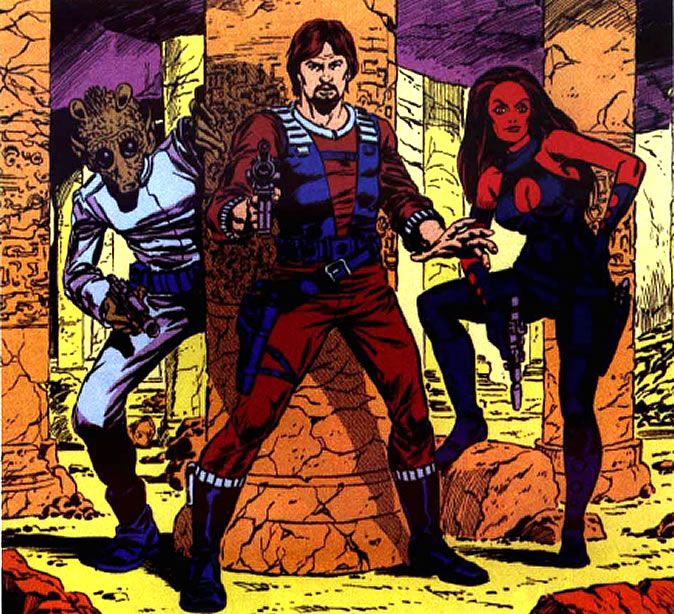Star Wars at Marvel (1977-1987): Reviews by Confessor
Jun 2, 2016 2:35:55 GMT -5
shaxper, Roquefort Raider, and 6 more like this
Post by Confessor on Jun 2, 2016 2:35:55 GMT -5
Star Wars: Return of the Jedi #1
Cover dated: October 1983
Issue title: In the Hands of Jabba the Hutt!
Script: Archie Goodwin
Artwork: Al Williamson (pencils & inks)/Carlos Garzon (pencils & inks)/Bill Sienkiewicz (pencils & inks - uncredited)
Colours: Christie Scheele, Bob Sharen
Letters: Ed King
Cover art: Bill Sienkiewicz
Overall rating: 9 out of 10
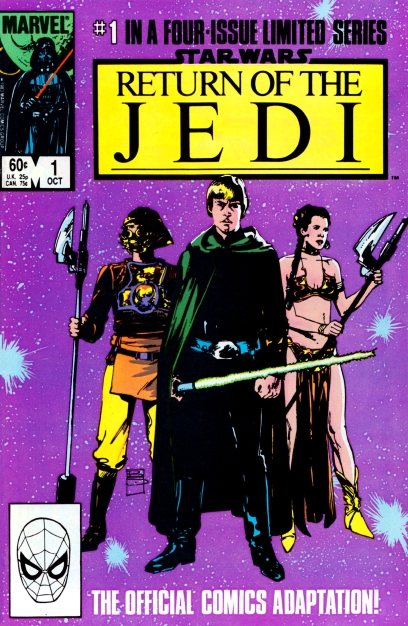
Plot summary: High above the forest moon of Endor, an Imperial shuttle approaches a new armoured space station that the Empire is building, which is even more powerful than the first Death Star. As the shuttle docks, Darth Vader disembarks to meet with Commander Jerjerrod and appraise the rate of construction. The commander assures the Dark Lord that the Death Star will be operational on schedule, but Vader warns Jerjerrod that the Emperor himself will soon be visiting the station and that he is displeased with the apparent lack of progress. Visibly shaken by this news, Jerjerrod vows that he and his men will immediately double their efforts.
Meanwhile, on the planet Tatooine, Luke Skywalker and Princess Leia have hatched a plan to rescue Han Solo from the gangster Jabba the Hutt. The two droids C-3PO and R2-D2 are dispatched to Jabba's palace in order to deliver a holographic message from Luke, in which the young Jedi offers to bargain with the Hutt for Solo's life. Jabba scoffs at the proposal and puts 3PO to work as his translator, while R2 is forced to become a serving droid on the Hutt's Sail Barge. Shortly afterwards, a mysterious bounty hunter named Boushh arrives at the palace, with a hand-cuffed Chewbacca in tow. Boushh forcefully negotiates a bounty for the Wookiee, and Chewbacca is summarily imprisoned.
Later that evening, with Jabba's court now deserted, Boushh approaches the carbon-frozen form of Han and frees him, as the mercenary reveals herself to be Leia in disguise. But before she can escape with Solo, the pair are captured. Solo is thrown into a cell with his Wookiee first mate, while Leia is forced to become Jabba's slave and wear a metal bikini, as Lando Calrissian – who managed to infiltrate the palace earlier and is now disguised as a guard – looks on.
Shortly afterwards, Luke gains entry to Jabba's palace and tells the crime lord that he is taking Solo and his friends with him and that it is up to the Hutt whether he wants to profit from this or be destroyed. Jabba refuses to release the Rebels and triggers a trap door beneath Luke's feet, causing the young Jedi to plunge down into a pit, where he is attacked by a towering, ferocious creature known as a Rancor. Luke kills the beast, which enrages Jabba to such a degree that he decides to execute Skywalker, Solo and Chewbacca by feeding them to the Sarlacc – a tentacled maw, with razor-sharp teeth located in the Great Pit of Carkoon, out in the Dune Sea.
Comments: So, here we have the long-awaited first instalment of the comic book adaptation of Star Wars: Episode VI – Return of the Jedi. Actually, this issue wasn't the first time that this adaptation appeared because Marvel had already published it in its entirety two months earlier in the paperback-sized The Marvel Comics Illustrated Version of Star Wars: Return of the Jedi and in Marvel Super Special #27: "Return of the Jedi". What this four-part monthly serialisation does offer though is some new opening splash pages and cover artwork by Bill Sienkiewicz, three extra splash pages illustrated by Rick Bryant (in issues #2, #3 and #4), and a host of bonus pin-up illustrations at the back of each issue.
Sienkiewicz's covers are pretty uninspiring overall and the garish colour scheme that he chooses for the backgrounds looks rather too '80s for my tastes. By contrast, Sienkiewicz's painted cover for Marvel Super Special #27 is absolutely gorgeous and deserves to be reproduced here in its original state, shorn of any cover blurb or title graphics...

This striking cover painting was also used in the UK for the hardcover Return of the Jedi annual and as the cover of Return of the Jedi Weekly #1.
As for the interior artwork, the Jedi adaptation sees the return of artists Al Williamson and Carlos Garzon, who had both worked so successfully on Marvel's version of The Empire Strikes Back. As a rule of thumb, the way in which Williamson and Garzon worked together was that the former would do panel and page layouts, along with the figures and foregrounds, while the latter would do backgrounds and hardware. Both artists would then ink their own work.
If you've been following my reviews you'll probably already know that I absolutely adore Williamson's artwork and consider him to be just about the best artist to have worked on Marvel's Star Wars series. His art is highly detailed, with photo-realistic tendencies, but it never sacrifices its inherent comic book qualities either. His locations and characters all have that wonderfully lived-in look, which dovetails nicely into the "used galaxy" aesthetic that George Lucas was striving for in his films. It's actually a bit of a shame that the covers of this mini-series weren't done by Williamson and Garzon too.
We get ample example of Williamson's beautiful artwork in this issue, with the artist liberally using his lush shadow work (or spot blacks, to use the correct terminology) in the scenes set within the dimly lit interior of Jabba the Hutt's palace...

In the Art of Al Williamson book, Lucas himself recounted how Williamson insisted on receiving only one chapter at a time of Archie Goodwin's script, while he worked on the adaptation. The reason for this is because the artist wanted to enjoy the story as he was drawing it, in a similar way to how cinema audiences would enjoy watching the film for the first time, wondering what was going to happen next.
As with their version of Empire, Williamson and Garzon do a really great job here, with plenty of inventive staging and "camera angels", while the panel-to-panel storytelling is basically flawless. However, I've always felt that the artwork in this adaptation was inferior to that found in the Empire one, although it's hard to explain exactly why. On the surface of things, Williamson's art is as gorgeous and effective as ever, but, I don't know, it feels slightly less inspired somehow. Less dynamic, less imbued with movement – as if it's just a little too reliant on reference photographs from Lucasfilm, rather than Williamson's own creativity and impeccable eye.
While we're on the subject of the artwork, I should note that the colouring in this mini-series and Marvel Super Special #27 is different to that which appeared in the paperback-sized The Marvel Comics Illustrated Version of Star Wars: Return of the Jedi. Christie Scheele and Bob Sharen handle the colouring here, but Ken Feduniewicz did the colouring for the paperback. Both colouring jobs compliment Williamson's artwork very nicely, although they are noticeably different to each other. Feduniewicz's colouring is the bolder of the two and definitely 'pops' more on the page, but it lacks the subtly of Scheele and Sharen's work and, to my eyes, puts too much emphasis on the backgrounds at times. Incidentally, both sets of colourist erroneously give Jabba's dancing girl Oola a human skin tone, when she should actually be green.
In the comparisons below, Scheele and Sharen's colouring is on the left, while Feduniewicz's work is on the right...


Many of the panels are noticeably cropped in the paperback version too, in order that the dialogue balloons should be legible in the smaller format. As for why Marvel had Feduniewicz colour the paperback-sized version, when they already had Scheele and Sharen doing the other editions, I'm not sure but I'm going to assume that it was something to do with the paper stock used for the paperback requiring a distinctly different palette.
I should also make mention of the fact that this adaptation represents the first time that we've see the cinematic version of Jabba in the Marvel comics. Although everybody's favourite intergalactic crime lord had previously appeared in issues #2, #28 and #37 of Star Wars, he had been depicted as a human-sized, bipedal alien, with yellow skin, rather than the bloated, slug-like creature we all know and love. The reason for that, as I explained in my review of Star Wars #2, was because when Howard Chaykin and Steve Leialoha drew issue #2, Lucasfilm hadn't yet decided on a finished design for the Hutt. The two artists therefore based their version on an alien creature seen briefly in the cantina sequence of Star Wars: Episode IV – A New Hope and it was this version of the character that was used for Jabba's subsequent appearances in the comic, prior to The Empire Strikes Back. No attempt is made in the adaptation of Return of the Jedi to reconcile the two markedly different versions of Jabba that Marvel had given us.
Would the real Jabba the Hutt please stand up (oh, that's right, he can't! )...
)...
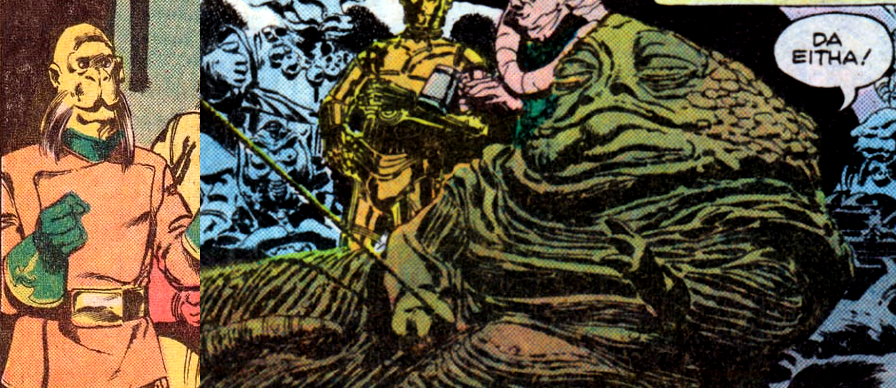
Something else that I just want to make quick mention of is that Williamson designed a new corner cover symbol for this mini-series, using artwork from his cover for Star Wars #39...
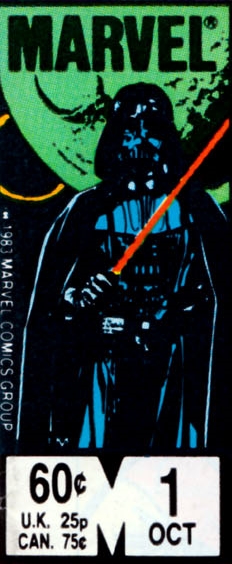
In addition to bringing Williamson and Garzon back, the Return of the Jedi adaptation also sees the return of writer Archie Goodwin to Marvel's Star Wars universe. Goodwin had been the regular writer on Star Wars from 1978 until 1981 and had also scripted Marvel's adaptation of The Empire Strikes Back. Here he does a marvelous job of bringing Lucas and Lawrence Kasdan's screenplay to the comic page and, in particular, his narration boxes give the adaptation a real air of drama.
Unlike the Marvel versions of A New Hope and Empire, there are no deleted scenes present in this adaptation, despite their inclusion in the film's shooting script. That observation, together with the fact that Williamson had to enlist the help of a number of fellow artists, including Ron Frenz, Tom Palmer, Dave Stevens, Tom Yeates, William Stout and Bill Sienkiewicz in later chapters, to help him make his deadline, suggests to me that this adaptation was produced in late 1982 and early 1983 – well into post-production and final editing of the movie. This also ties-in with comments made by the former writer on the Star Wars comic, David Michelinie, about having made the decision to leave the book in mid-1982, after realising that he wouldn't be scripting the comic book version of the third Star Wars film.
Given this time frame, I have a hunch that Goodwin actually based much of his script on the then-unpublished Return of the Jedi novelization by James Kahn. Maybe Lucasfilm provided Goodwin with a copy of Kahn's manuscript in order to accelerate production of the comic book? Certainly, there are pieces of dialogue in this first chapter of the adaptation – like having Jabba refer to C-3PO as his "talkdroid" and later telling Luke Skywalker that he had been "killing your kind when being a Jedi meant something" – which are not present in the film's shooting script, but are included in Kahn's book. Actually, I think that line about killing Jedi Knights is a really great piece of in-character dialogue and makes Jabba seem a lot nastier and even more threatening than he was in the film.
Goodwin also gives us a noticeably different version of the film's signature opening crawl...
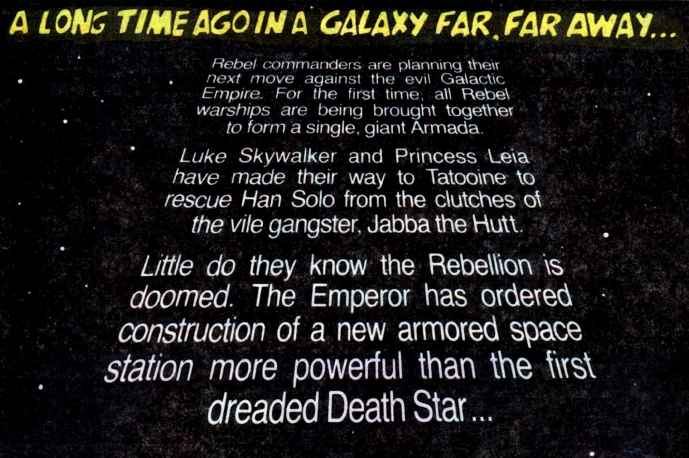
Another very noticeable difference between the two previous Star Wars film adaptations that Marvel had given us and this one, is that Jedi is serialised in four parts, rather than six. This adaptation also wasn't included as a part of the regular ongoing comic series. I've always assumed that Marvel decided to serialise the Jedi adaptation in a separate four issue mini-series as a way to get two Star Wars comics on the shelves each month, as consumer interest in the franchise grew to fever pitch.
Of course, that still doesn't explain why Marvel didn't commission a six-part comic adaptation, as they had done for the other Star Wars films, since, in terms of profit, six issues would've earned them more than four. Personally, I think that the most likely reason for the shortened adaptation of Jedi is that Williamson wouldn't commit to drawing any more – let's not forget that he was also drawing the daily Star Wars newspaper strip at this point, which wasn't the case when he did the Empire adaptation. By his own admission, Williamson had never been a particularly fast artist and I think he knew that he wouldn't be able to do all of the work required on time, had the adaptation been extended to six issues. Even keeping it at four issues, Williamson almost missed his deadline and had to bring in additional artists, as I mentioned above.
Summing up, this first chapter of Return of the Jedi is as well paced and exciting as its cinematic counterpart. Yes, the artwork is slightly less exciting than Williamson's previous contributions to Marvel's Star Wars series, but still, I'll take slightly substandard Williamson art over pretty much anybody else's, so it's really not a deal breaker. This issue has some very serviceable scripting, some beautiful artwork, and is a very enjoyable comic overall.
Continuity issues:
Favourite panel:

Favourite quote: "Jedi mind tricks will not work on me, boy. I am not affected by your human thought pattern. I was killing your kind when being a Jedi meant something!" – Jabba the Hutt taunts Luke Skywalker about his ability to resist the young Jedi's Force powers.
Cover dated: October 1983
Issue title: In the Hands of Jabba the Hutt!
Script: Archie Goodwin
Artwork: Al Williamson (pencils & inks)/Carlos Garzon (pencils & inks)/Bill Sienkiewicz (pencils & inks - uncredited)
Colours: Christie Scheele, Bob Sharen
Letters: Ed King
Cover art: Bill Sienkiewicz
Overall rating: 9 out of 10

Plot summary: High above the forest moon of Endor, an Imperial shuttle approaches a new armoured space station that the Empire is building, which is even more powerful than the first Death Star. As the shuttle docks, Darth Vader disembarks to meet with Commander Jerjerrod and appraise the rate of construction. The commander assures the Dark Lord that the Death Star will be operational on schedule, but Vader warns Jerjerrod that the Emperor himself will soon be visiting the station and that he is displeased with the apparent lack of progress. Visibly shaken by this news, Jerjerrod vows that he and his men will immediately double their efforts.
Meanwhile, on the planet Tatooine, Luke Skywalker and Princess Leia have hatched a plan to rescue Han Solo from the gangster Jabba the Hutt. The two droids C-3PO and R2-D2 are dispatched to Jabba's palace in order to deliver a holographic message from Luke, in which the young Jedi offers to bargain with the Hutt for Solo's life. Jabba scoffs at the proposal and puts 3PO to work as his translator, while R2 is forced to become a serving droid on the Hutt's Sail Barge. Shortly afterwards, a mysterious bounty hunter named Boushh arrives at the palace, with a hand-cuffed Chewbacca in tow. Boushh forcefully negotiates a bounty for the Wookiee, and Chewbacca is summarily imprisoned.
Later that evening, with Jabba's court now deserted, Boushh approaches the carbon-frozen form of Han and frees him, as the mercenary reveals herself to be Leia in disguise. But before she can escape with Solo, the pair are captured. Solo is thrown into a cell with his Wookiee first mate, while Leia is forced to become Jabba's slave and wear a metal bikini, as Lando Calrissian – who managed to infiltrate the palace earlier and is now disguised as a guard – looks on.
Shortly afterwards, Luke gains entry to Jabba's palace and tells the crime lord that he is taking Solo and his friends with him and that it is up to the Hutt whether he wants to profit from this or be destroyed. Jabba refuses to release the Rebels and triggers a trap door beneath Luke's feet, causing the young Jedi to plunge down into a pit, where he is attacked by a towering, ferocious creature known as a Rancor. Luke kills the beast, which enrages Jabba to such a degree that he decides to execute Skywalker, Solo and Chewbacca by feeding them to the Sarlacc – a tentacled maw, with razor-sharp teeth located in the Great Pit of Carkoon, out in the Dune Sea.
Comments: So, here we have the long-awaited first instalment of the comic book adaptation of Star Wars: Episode VI – Return of the Jedi. Actually, this issue wasn't the first time that this adaptation appeared because Marvel had already published it in its entirety two months earlier in the paperback-sized The Marvel Comics Illustrated Version of Star Wars: Return of the Jedi and in Marvel Super Special #27: "Return of the Jedi". What this four-part monthly serialisation does offer though is some new opening splash pages and cover artwork by Bill Sienkiewicz, three extra splash pages illustrated by Rick Bryant (in issues #2, #3 and #4), and a host of bonus pin-up illustrations at the back of each issue.
Sienkiewicz's covers are pretty uninspiring overall and the garish colour scheme that he chooses for the backgrounds looks rather too '80s for my tastes. By contrast, Sienkiewicz's painted cover for Marvel Super Special #27 is absolutely gorgeous and deserves to be reproduced here in its original state, shorn of any cover blurb or title graphics...

This striking cover painting was also used in the UK for the hardcover Return of the Jedi annual and as the cover of Return of the Jedi Weekly #1.
As for the interior artwork, the Jedi adaptation sees the return of artists Al Williamson and Carlos Garzon, who had both worked so successfully on Marvel's version of The Empire Strikes Back. As a rule of thumb, the way in which Williamson and Garzon worked together was that the former would do panel and page layouts, along with the figures and foregrounds, while the latter would do backgrounds and hardware. Both artists would then ink their own work.
If you've been following my reviews you'll probably already know that I absolutely adore Williamson's artwork and consider him to be just about the best artist to have worked on Marvel's Star Wars series. His art is highly detailed, with photo-realistic tendencies, but it never sacrifices its inherent comic book qualities either. His locations and characters all have that wonderfully lived-in look, which dovetails nicely into the "used galaxy" aesthetic that George Lucas was striving for in his films. It's actually a bit of a shame that the covers of this mini-series weren't done by Williamson and Garzon too.
We get ample example of Williamson's beautiful artwork in this issue, with the artist liberally using his lush shadow work (or spot blacks, to use the correct terminology) in the scenes set within the dimly lit interior of Jabba the Hutt's palace...

In the Art of Al Williamson book, Lucas himself recounted how Williamson insisted on receiving only one chapter at a time of Archie Goodwin's script, while he worked on the adaptation. The reason for this is because the artist wanted to enjoy the story as he was drawing it, in a similar way to how cinema audiences would enjoy watching the film for the first time, wondering what was going to happen next.
As with their version of Empire, Williamson and Garzon do a really great job here, with plenty of inventive staging and "camera angels", while the panel-to-panel storytelling is basically flawless. However, I've always felt that the artwork in this adaptation was inferior to that found in the Empire one, although it's hard to explain exactly why. On the surface of things, Williamson's art is as gorgeous and effective as ever, but, I don't know, it feels slightly less inspired somehow. Less dynamic, less imbued with movement – as if it's just a little too reliant on reference photographs from Lucasfilm, rather than Williamson's own creativity and impeccable eye.
While we're on the subject of the artwork, I should note that the colouring in this mini-series and Marvel Super Special #27 is different to that which appeared in the paperback-sized The Marvel Comics Illustrated Version of Star Wars: Return of the Jedi. Christie Scheele and Bob Sharen handle the colouring here, but Ken Feduniewicz did the colouring for the paperback. Both colouring jobs compliment Williamson's artwork very nicely, although they are noticeably different to each other. Feduniewicz's colouring is the bolder of the two and definitely 'pops' more on the page, but it lacks the subtly of Scheele and Sharen's work and, to my eyes, puts too much emphasis on the backgrounds at times. Incidentally, both sets of colourist erroneously give Jabba's dancing girl Oola a human skin tone, when she should actually be green.
In the comparisons below, Scheele and Sharen's colouring is on the left, while Feduniewicz's work is on the right...


Many of the panels are noticeably cropped in the paperback version too, in order that the dialogue balloons should be legible in the smaller format. As for why Marvel had Feduniewicz colour the paperback-sized version, when they already had Scheele and Sharen doing the other editions, I'm not sure but I'm going to assume that it was something to do with the paper stock used for the paperback requiring a distinctly different palette.
I should also make mention of the fact that this adaptation represents the first time that we've see the cinematic version of Jabba in the Marvel comics. Although everybody's favourite intergalactic crime lord had previously appeared in issues #2, #28 and #37 of Star Wars, he had been depicted as a human-sized, bipedal alien, with yellow skin, rather than the bloated, slug-like creature we all know and love. The reason for that, as I explained in my review of Star Wars #2, was because when Howard Chaykin and Steve Leialoha drew issue #2, Lucasfilm hadn't yet decided on a finished design for the Hutt. The two artists therefore based their version on an alien creature seen briefly in the cantina sequence of Star Wars: Episode IV – A New Hope and it was this version of the character that was used for Jabba's subsequent appearances in the comic, prior to The Empire Strikes Back. No attempt is made in the adaptation of Return of the Jedi to reconcile the two markedly different versions of Jabba that Marvel had given us.
Would the real Jabba the Hutt please stand up (oh, that's right, he can't!
 )...
)...
Something else that I just want to make quick mention of is that Williamson designed a new corner cover symbol for this mini-series, using artwork from his cover for Star Wars #39...

In addition to bringing Williamson and Garzon back, the Return of the Jedi adaptation also sees the return of writer Archie Goodwin to Marvel's Star Wars universe. Goodwin had been the regular writer on Star Wars from 1978 until 1981 and had also scripted Marvel's adaptation of The Empire Strikes Back. Here he does a marvelous job of bringing Lucas and Lawrence Kasdan's screenplay to the comic page and, in particular, his narration boxes give the adaptation a real air of drama.
Unlike the Marvel versions of A New Hope and Empire, there are no deleted scenes present in this adaptation, despite their inclusion in the film's shooting script. That observation, together with the fact that Williamson had to enlist the help of a number of fellow artists, including Ron Frenz, Tom Palmer, Dave Stevens, Tom Yeates, William Stout and Bill Sienkiewicz in later chapters, to help him make his deadline, suggests to me that this adaptation was produced in late 1982 and early 1983 – well into post-production and final editing of the movie. This also ties-in with comments made by the former writer on the Star Wars comic, David Michelinie, about having made the decision to leave the book in mid-1982, after realising that he wouldn't be scripting the comic book version of the third Star Wars film.
Given this time frame, I have a hunch that Goodwin actually based much of his script on the then-unpublished Return of the Jedi novelization by James Kahn. Maybe Lucasfilm provided Goodwin with a copy of Kahn's manuscript in order to accelerate production of the comic book? Certainly, there are pieces of dialogue in this first chapter of the adaptation – like having Jabba refer to C-3PO as his "talkdroid" and later telling Luke Skywalker that he had been "killing your kind when being a Jedi meant something" – which are not present in the film's shooting script, but are included in Kahn's book. Actually, I think that line about killing Jedi Knights is a really great piece of in-character dialogue and makes Jabba seem a lot nastier and even more threatening than he was in the film.
Goodwin also gives us a noticeably different version of the film's signature opening crawl...

Another very noticeable difference between the two previous Star Wars film adaptations that Marvel had given us and this one, is that Jedi is serialised in four parts, rather than six. This adaptation also wasn't included as a part of the regular ongoing comic series. I've always assumed that Marvel decided to serialise the Jedi adaptation in a separate four issue mini-series as a way to get two Star Wars comics on the shelves each month, as consumer interest in the franchise grew to fever pitch.
Of course, that still doesn't explain why Marvel didn't commission a six-part comic adaptation, as they had done for the other Star Wars films, since, in terms of profit, six issues would've earned them more than four. Personally, I think that the most likely reason for the shortened adaptation of Jedi is that Williamson wouldn't commit to drawing any more – let's not forget that he was also drawing the daily Star Wars newspaper strip at this point, which wasn't the case when he did the Empire adaptation. By his own admission, Williamson had never been a particularly fast artist and I think he knew that he wouldn't be able to do all of the work required on time, had the adaptation been extended to six issues. Even keeping it at four issues, Williamson almost missed his deadline and had to bring in additional artists, as I mentioned above.
Summing up, this first chapter of Return of the Jedi is as well paced and exciting as its cinematic counterpart. Yes, the artwork is slightly less exciting than Williamson's previous contributions to Marvel's Star Wars series, but still, I'll take slightly substandard Williamson art over pretty much anybody else's, so it's really not a deal breaker. This issue has some very serviceable scripting, some beautiful artwork, and is a very enjoyable comic overall.
Continuity issues:
- Oola is incorrectly coloured with pink, human-like skin, when she should be green.
- It is hinted in this issue that the Rancor is native to Tatooine, but later expanded universe sources have established that the creature comes from the planet Dathomir.
Favourite panel:

Favourite quote: "Jedi mind tricks will not work on me, boy. I am not affected by your human thought pattern. I was killing your kind when being a Jedi meant something!" – Jabba the Hutt taunts Luke Skywalker about his ability to resist the young Jedi's Force powers.
